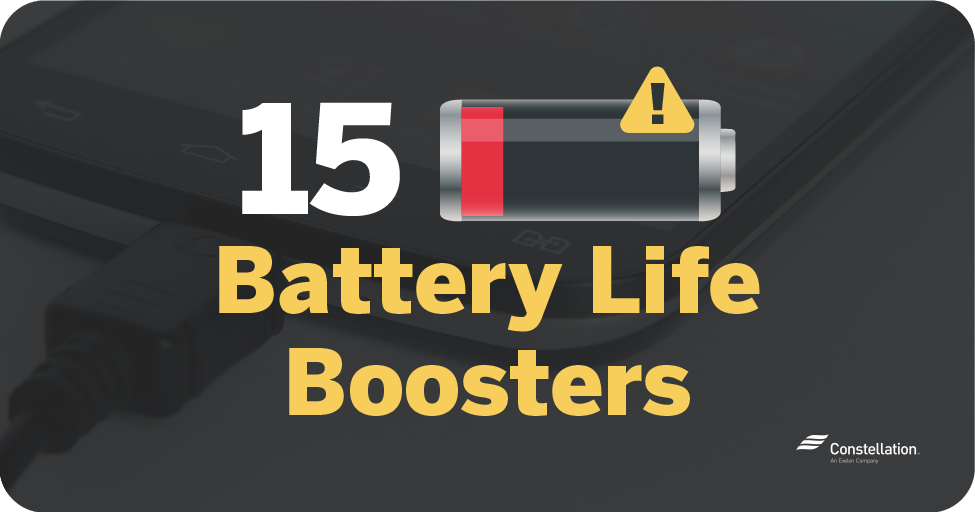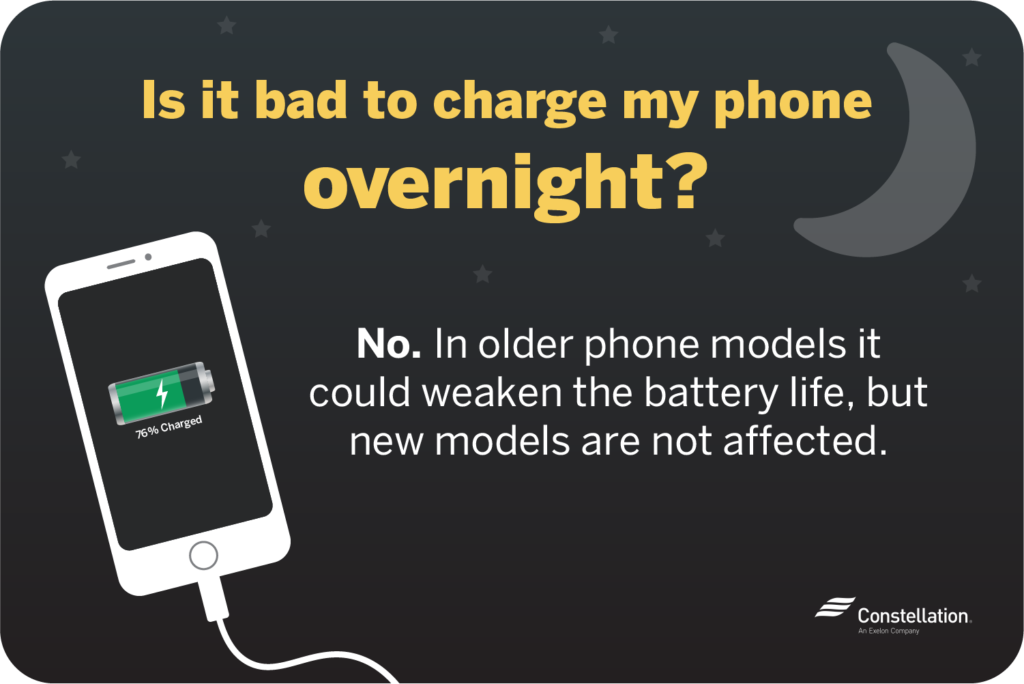
- Category:
Home Energy Savings -
Last updated:
March 9, 2021
15 Battery Life Boosters: How to Save Energy on Your Phone
Wireless technology has become so commonplace that most people hardly notice how much it has changed our lives. Mobile devices allow us to text, phone and access the internet from anywhere with a wireless signal, freeing us from the physical limitations of bulkier computers and traditional telephones.
How you choose to charge a wireless device affects both the amount of energy consumed and the life of your battery. It’s important to know whether you should charge your phone to 100 percent or whether leaving a charger plugged in overnight wastes power. Knowing this allows you to make the most effective use of your mobile devices and helps you save energy.
How much energy does a phone charger use?
Compared to a television or smart home appliance, the amount of energy required to operate a cell phone is extremely economical. According to the Energy Use Calculator, the amount of energy consumed per mobile device is surprisingly low: A cell phone charger using 5 watts for 3 hours only consumes 0.01 kilowatt-hours per day. Leaving a charger plugged in without charging a device will only consume half a watt a day, which costs you approximately 44 cents a year.
The issue, then, is less about conserving energy (although every saved kilowatt-hour of energy helps) and more about how charging those devices affects their battery life.
15 tips to prolong your battery life for your phone
Before we jump into addressing how to prolong a wireless device’s battery life, it’s important to understand the difference between battery life and battery lifespan. Battery life is how long your device will run before the battery needs recharging. Battery lifespan refers to how long your battery will last before it loses the ability to hold a charge.
If a mobile device doesn’t have a replaceable battery, battery lifespan determines the working life of the device. Below are some suggestions for prolonging both battery life and battery lifespan.
1. Update to your phone’s latest software.
A new update to your mobile device’s operating system doesn’t just improve security or add new features. New updates also improve the device’s energy efficiency, allowing you to get more use out of every battery charge.
2. Enable low-power and energy-saving modes on your devices.
Low-power and energy-saving modes optimize device performance by reducing display brightness while temporarily ceasing functions such as uploading to the cloud and background downloads. In low-power mode, you can still text, send emails, make phone calls and access the internet.
Mobile devices can be set to prompt you to go into low-power mode when your battery level drops to 20%. You can use low-power mode whenever you want to eke as much life out of your battery as possible (such as during a long trip when you might not have access to charging stations).
3. Turn off Raise to Wake on your phone.
If you’re using an iPhone, the phone is set to Raise to Wake mode by default. This setting automatically turns on the iPhone’s lock screen when the user raises the phone to look at it. Consistently activating the lock screen will drain your battery, so unless you use your phone every time you pick it up, turn off this setting.
4. Dim your screen brightness on your devices.
Lowering your screen brightness can extend your battery life, as less power is needed to light the screen. How much battery life a dimmer screen saves varies depending on the device, model and usage. It’s possible to gain an extra hour or two of power by adjusting brightness settings.
5. Keep your devices out of extreme temperatures.
High temperatures can damage the internal components of a mobile device, including the battery. Most devices work best between 62 and 72 degrees Fahrenheit. At temperatures higher than 95 degrees Fahrenheit, battery lifespan can be permanently reduced. Batteries will drain faster in cold temperatures, but this is a temporary condition.
6. Remove phone or tablet cases when charging.
Your phone case can also affect battery lifespan. Heavy, bulky cases trap excess heat when charging, which can reduce battery capacity. If your phone gets hot when it’s charging, take it out of its case before using plug-in or wireless chargers.
7. Plug your devices into a smart plug.
When chargers are plugged into an outlet, they consume small amounts of energy even when they’re not actively charging devices. Smart plugs can be set to turn off power to the charger after a set amount of time. Smart plugs can also be used with home security systems like Constellation Connect to monitor and save on energy use.
Constellation Connect protects your home.
And your peace of mind.
8. Quit mobile applications when not in use.
Every app running on your mobile device uses energy and decreases battery life. This includes apps that run quietly in the background. To get the most life out of your battery, turn off all apps that are not in use.
9. Turn off location services on your device.
Location services actively interface with satellites to pinpoint your exact location. When location services are turned on, your phone can’t go into sleep mode and conserve battery life. Additionally, when in poor signal areas, location services will have to work harder to connect to GPS satellites, further draining your battery. Unless you need them for a specific app, keep your location services turned off.
10. Check whether you have a low signal or coverage.
You’ve probably noticed that your mobile device’s coverage changes depending on your location. Big-box stores with metal roofs, for example, inhibit cell phone coverage. Phones must work harder to send and receive information in low-coverage locations, draining batteries faster. If possible, avoid using your phone until you receive a stronger signal.
11. Turn off your Wi-Fi when not in use.
There’s some disagreement about how much power is drained by leaving your Wi-Fi on, especially in newer phones. Turning off Wi-Fi will save some battery life, but remember to turn it back on at home or you’ll be running through your data allotment unnecessarily.
12. Store your devices at half charge.
If you’ve ever had to store a mobile device for a long period of time, you may have wondered what percentage to charge the phone before storage. You should not charge your phone to 100% before storing it, as this can lead to a shorter battery lifespan.
Conversely, you shouldn’t fully discharge a mobile device before storage, as long-term disuse in a fully discharged state can lead to the battery losing the ability to hold a charge.The best percentage to charge phones before storage is 50%, with the device completely powered down. For long-term storage, charge the phone to 50% every six months.
13. Use safe and reliable charging cables.
Damage to power cables makes charging less efficient, increasing the amount of time and energy needed to charge a device. In addition, old, frayed charging cables are potential fire hazards and should be replaced.
14. Charge your phone from a computer that’s powered on.
It’s possible to charge a mobile device from a computer that’s powered off, hibernating or in sleep mode, but doing so puts pressure on both the computer and the phone. Only charge phones through computers when the computer is turned on.
15. Replace your phone’s battery if it’s old.
As batteries age, their capacity to hold a charge diminishes. Eventually, the battery needs replacing. Although replacing the battery is still possible with some mobile device models, the push for smaller, thinner devices has led to smaller batteries, which in turn has made it difficult to replace batteries in newer models. Still, if you have an older phone, replacing the battery can rejuvenate the device’s ability to hold a charge.
Is it bad to charge my phone overnight?
Charging a phone overnight can have a negative effect on battery lifespan for older mobile models. Leaving a charger plugged in uses electricity: Once an older phone is fully charged, the device continues to receive small trickles of power every time the battery charge dips below 100%, slowly reducing battery capacity. In newer phones, this problem has been resolved, and leaving a phone plugged in overnight no longer has this effect. The difference lies in how newer lithium-ion batteries work.

How lithium-ion batteries work
Mobile devices use lithium-ion batteries, which diminish in capacity based on set cycle amounts. This means, the number of full charges the battery can take before capacity is significantly reduced. If you drain a third of your battery life and then recharge the battery, you’ve consumed a third of a cycle.
Most modern smartphone batteries can go through 400 or more charge cycles, so the battery will perform at full capacity for at least a year and a half. Charging a phone overnight has no significant impact on charge cycles.
Should you charge your phone to 100%?
Yes, it’s fine to charge your phone to 100%. Partially charging your phone will not extend its charging cycle — you’ll just have to recharge more often.
Is it bad to use your phone while charging?
No, it’s not bad to use your phone while charging. The nature of lithium-ion batteries means your battery capacity is tied to the total number of charge cycles used. The only negative aspect of using a phone while it charges is that your mobility is limited by the charging cord.
Is wireless charging better than using charger cables?
There’s always something appealing about the latest home technology, including wireless charging bases. Wireless charging bases have some advantages and disadvantages when compared to traditional charging cords. With a wireless charger, there’s no need to connect the phone to a cable, reducing the amount of wear and tear on the phone’s mini-USB port. Multiple phones can charge from the same base instead of each needing its own charging cable, and wireless charging avoids any risk of electric shocks caused by faulty cables.
On the other hand, cable charging can be much faster than some wireless charging, which can take twice as long to fully charge a phone. Cables also allow you to use phones while they’re charging.
If you’re interested in being as energy-efficient as possible, pairing a traditional cable charger with a smart plug turns it into a smart home device, one you can control remotely for additional energy savings.
What percentage you charge your phone to and whether you’re leaving a charger plugged in all night won’t have a significant impact on your phone’s battery capacity. Extreme temperatures, heavy cases and energy-hungry phone settings, however, can drain mobile device batteries quickly and reduce battery life. If you pay attention to such factors, you’ll make the most efficient use of your phone — and lower the risk that it’ll be out of juice just when you need it most.




